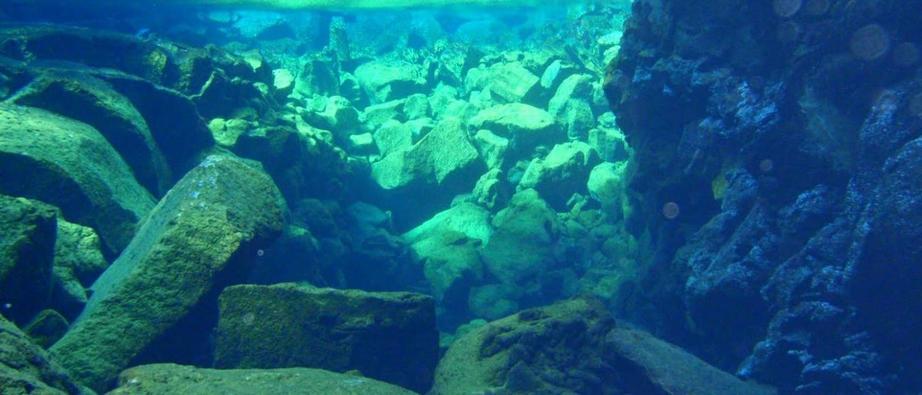Nine mysterious ancient ruins we still know almost nothing about
Much of what we know about ancient cultures today comes from the pictures and written documents left behind. In some cases, artifacts can leave clues as to who the people were that created ancient monuments that are now ruins, but in other instances, there are more questions than answers. Historians, archaeologists, and geologists have many theories about the ruins on this list, but they are just that: theories. These ancient ruins most hold more questions than answers and in some cases, experts are not even certain that they are man-made.
Lake Michigan Stonehenge
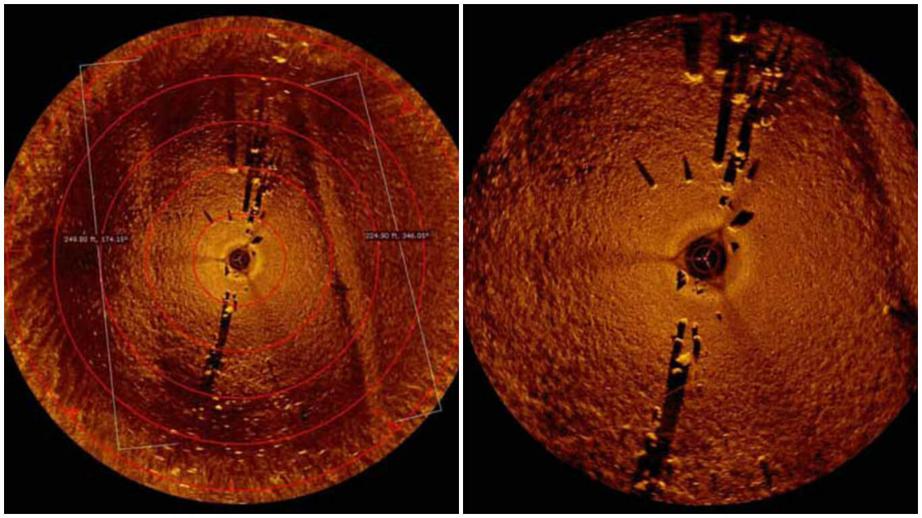
Pictures of the rock formation found at the bottom of Lake Michigan
In 2007, Mark Holley was scanning the floor of Lake Michigan in search of shipwrecks. Instead he found what some have dubbed to be the Lake Michigan Stonehenge. 40 feet below the surface are large stones arranged in a circular formation. There is very little known about who built this structure and why it was built. The location of the site has been kept secret in order to follow the wishes of the Traverse Bay American Indian community who seek to preserve the site.
The stones may not look remarkable, but they are almost perfectly aligned with each other. If they were placed by humans, then the circular rock formation would have to date back between 6,000 and 10,000 years. It was 6,000 years ago that this area of Lake Michigan was dry and served as a home for hunter-gatherers. The reason why some suggest the rock formation may be older than 6,000 years has to do with what was discovered on one of the outer rings of the rock circle.
Divers found carved into a large block of granite a petroglyph that looks like a mastodon. The ancient elephant went extinct 10,000 years ago, so for an ancient human to have carved it, they would have needed to be alive at the same time. Unfortunately, petroglyph experts are not typically divers and therefore have not been able to view the carving in person. But if it is verified, it only raises more questions, such as how were the ancient people able to carve so deeply and precisely into granite?
The site stands out because it is understood that humans did not have the capacity for structures such as this until they settled down into villages and moved out of the hunter-gather phase. While there are very few answers about the site it would not be the first formation or the first petroglyph to be found underwater or found in the Lake Michigan area, so it is possible that the formation is real.
Japan’s Underwater Ruins
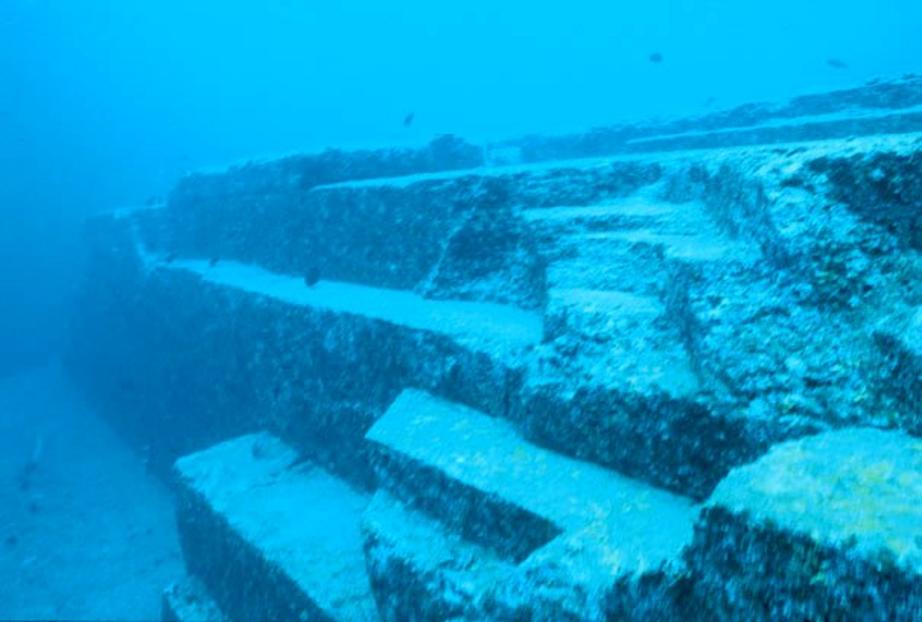
Photo of the rock formation at Yonaguni
Off the coast of Japan’s Yonaguni island are mysterious rock formations that have led to intense debate among archaeologists and geologists. These large stone structures appear to be large, stepped monoliths. Some of the ruins have walls that are 33 feet tall and columns that rise to within 8 feet of the surface. There are square shapes and formations that look like figures, such as the turtle and the giant face have convinced some that the formations are man-made.
The argument that the structures are man-made comes from the presence of right angles as part of the structure and the twin megaliths that appear to have been placed there. Maasaki Kimura, who first discovered the site, says that he had found traces of animal drawings and people in the rocks and a symbol that he believes to be a character from the Kaida script.
Kimura claims that he can identify castles, roads, monuments, and even a stadium in the rock formations. If true this would be astonishing as some date the ruins back 10,000 years. Others present more conservative estimates of 2,000 to 3,000 years, which would still be an astonishing find and would lead to questions about who could have constructed the ruins. Kimura theorized that the ruins could be part of the mythical lost continent of Mu.
On the other side of the debate are geologists who claim that all of the formations are naturally occurring. Yonaguni is found in an earthquake prone region and earthquakes have been known to cause sandstone to fracture in shapes similar to those found at the ruins. They believe the roads are just channels in the rock and the vertical formations are just rocks that were horizontal but fell vertical when the rocks below them eroded. Others say it is unusual to see so many of these types of formations in such a small area but there is no definitive evidence that concludes the formations at Yonaguni are indeed man-made.
Gobekli Tepe
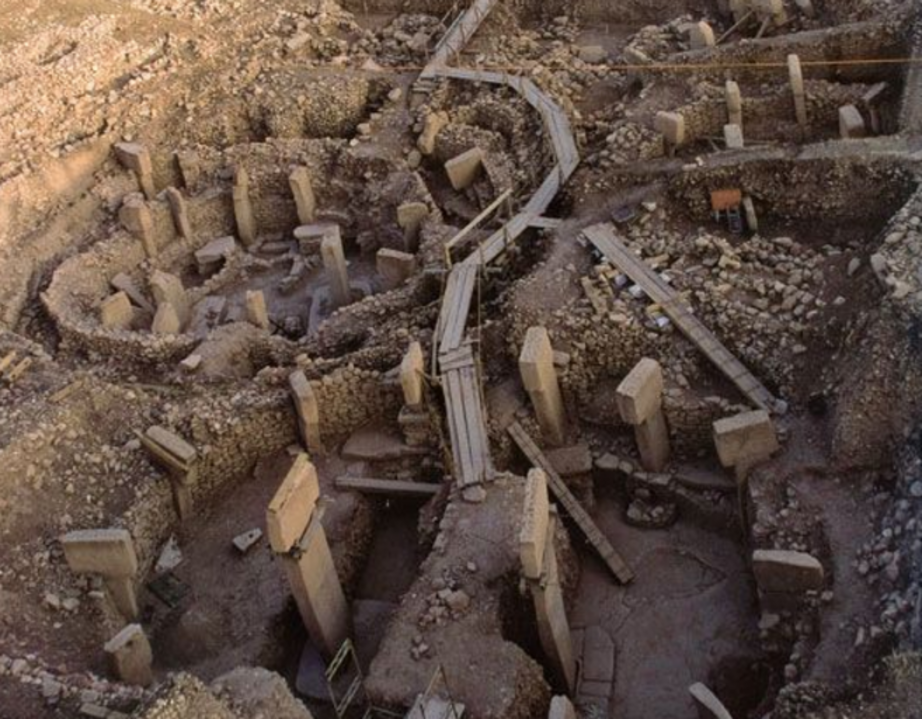
Gobekli Tepe
Gobekli Tepe is an archaeological site that has the potential to completely change how historians and archaeologists understand human history. It challenges many of the assumptions that were made about hunter-gatherers and what led up to the transition to farming raising livestock. Gobekli Tepe is an ancient site located in Turkey and unlike other ruins on this list, there is no doubt that this one is man-made.
The site was discovered during a survey in 1963 conducted by Istanbul University and the University of Chicago, but it was mostly written off as little more than a medieval burial ground. In 1994, Klaus Schmidt found the survey information on Gobekli Tepe and decided to take a closer look. Upon arriving at the mound, he recognized that the limestone rocks and slabs had the potential to be more than just gravestone but rather T-shaped pillars. Excavation began the following year and it was not long before the team uncovered the massive pillars that had been buried beneath the surface.
The site was created by placing a ring of the massive seven-ton stone pillars on the ground. This ring would then be covered with dirt. Another ring of stone pillars would be placed on top of the dirt and covered. This continued to create a gently sloping mound. The ruins are dated back 11,000 years and were created at a time when the region was only known to have hunter-gatherers. A structure of this sort would have taken a large number of people working for an extended period. Bones found at the site confirm that whoever built the site did plenty of hunting of wild animals.
This challenges the notion that it was only after hunter-gatherers settled down that they had the manpower and skill to create large structures. Interestingly enough it was just a few centuries after the construction of Gobekli Tepe that there is evidence of farming and domestication of grain and animals. For some this means that it was the need to create the structure that prompted the hunter-gatherers to settle down.
Nan Madol

Part of the ruins at Nan Madol
Nan Madol is an ancient city built atop a coral reef in Micronesia. It is believed to be the only ancient city ever built upon a coral reef, but that is just the beginning of what makes this site fascinating. To date, no one has figured out how the people who lived here were able to build it, what tools they used to do it, where they got the stone, or even how they were able to lift up the columns used to make the wall.
Construction on the city is believed to have started by the 8th or 9th century with the megalithic architecture starting in 1200 CE. The city was the ceremonial and political seat of the Saudeleur Dynasty which brought together the 25,000 people of Pohnpei. Pohnpeian legend tells us that Nan Madol was built by twin sorcerers Olisihpa and Olosopha, who used a flying dragon to lift the massive stones.
A single cornerstone of Nandowas, the royal mortuary, is estimated to weigh 50 tons. All the stones moved to the site are estimated to be 750,000 metric tons. An impressive feat for people who had no pulleys, no levers and no metal. Construction of the site took four centuries as it was built in stages but even over 400 years, 1,850 tons of rock would need to be moved and placed each year. Considering the population was only 25,000 that is a monumental undertaking that has yet to be explained.
The city itself was only meant to house 500 to 1000 people. It was a place of residence for the nobility and ruling chiefs. It was also where commoners who could not be trusted were forced to live so that they could always be watched. There was no access to fresh water or food for the people of Nan Madol, it all had to be brought to the city by boat. The city became abandoned in the 17th century but was still used for religious ceremonies up until the late 19th century.
Puma Punku

Ruins at Puma Punku
Puma Punku is an ancient ruin found in Bolivia that dates back to the 6th century CE. It stands out for a number of reasons, both for its history and for its construction. The site features stonework that is unlike anything of the period. Precise cuts were made to not only add detail to the ruins but also to precisely fit the massive stone blocks together. The blocks were cut at exact angles so that they would fit together like a puzzle and not require the use of mortar of any kind. Even centuries later the rocks fit so tightly together that not even a razor blade can slip between them.
The intricate carvings on the rocks with straight lines and angles also stand out. There are no chisel marks of any kind and trying to recreate these cuts with the tools known to be available at the time has yet to be accomplished. Moving the rocks to the site was even a feat as some weighed as much as 100 tons and were moved from a quarry 60 miles from the site. The ruins exist above the tree line so there were not even any trees to use to make rollers to move the massive blocks.
There is even contention over the dating of the ruins. Some put the ruins at over 10,000 years old, despite the carbon dating. When the Incas conquered the region in the 15th century, they incorporated Puma Punku and the rest of Tiwanku city into their empire. Puma Punku became a huge part of the Incan culture because it was believed to be the place where Viracocha created the ancestral people of all ethnicities and sent them out to populate the world.
While it is not known for certain, it is theorized that Puma Punku served as a spiritual and religious center. At its peak Puma Punku and Tiwanaku city supported 400,000 people and had a very extensive infrastructure. By 1000 CE the culture abruptly ended for reasons that are still unknown today.
Ggantija
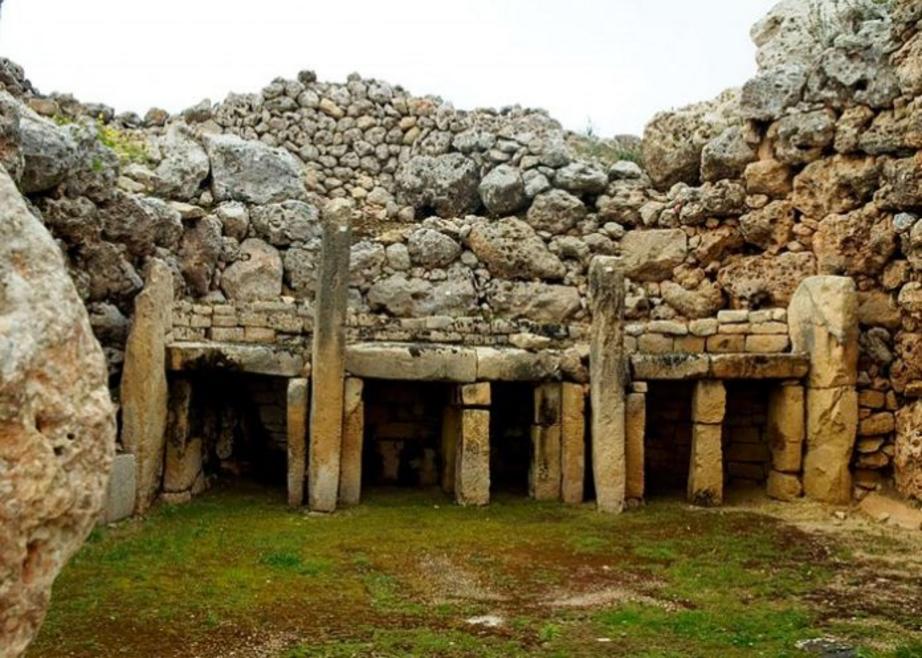
Part of the ruins of Ggantija
The ruins at Ggantija are the second oldest religious structures in the world, second only to the ruins at Gobekli Tepe. These temples date back more than 5,500 years which makes them older than the pyramids of Egypt. They are found on the Mediterranean island of Gozo. The temples have become a part of Gozitan folklore which says that the temples were built by giantess.
At the site, there are actually two complete temples and one temple that was abandoned before it was finished. The southernmost temple is the best preserve and the oldest dating back to 3,600 BCE. The temple’s plan includes five huge apses that still have traces of the plaster that once covered them slinging between the rocks. The temple are arranged in a clover leaf shape. They consist of semi-circular apses connected by a passage down the middle. Today it is believed that the apses would have been covered by roofing.
The building of the temple predates the wheel and metal tools which makes the feat even more impressive. Small round stones were found at the site which have some archaeologists guessing that the small stones were used as ball bearings to transport the massive stones. Even though the site was discovered in the 17th century very little was done on the site until 1827 when it was cleared of debris. After the clearing of debris, the site fell into decay and was kept in private hands until 1933 when it was expropriated for public benefit, finally allowing the site to be fully excavated, preserved and studied.
There is still very little known about the site. Findings of animal bones in the apses suggest that it may have been used for animal sacrifice. A large stone at the entrance with a recess might have been used as a ritual ablution station for purification before anyone could enter the complex. The temple does face to the southeast and the equinox sunrise which adds to the belief it was a religious site.
Menorcan Taulas
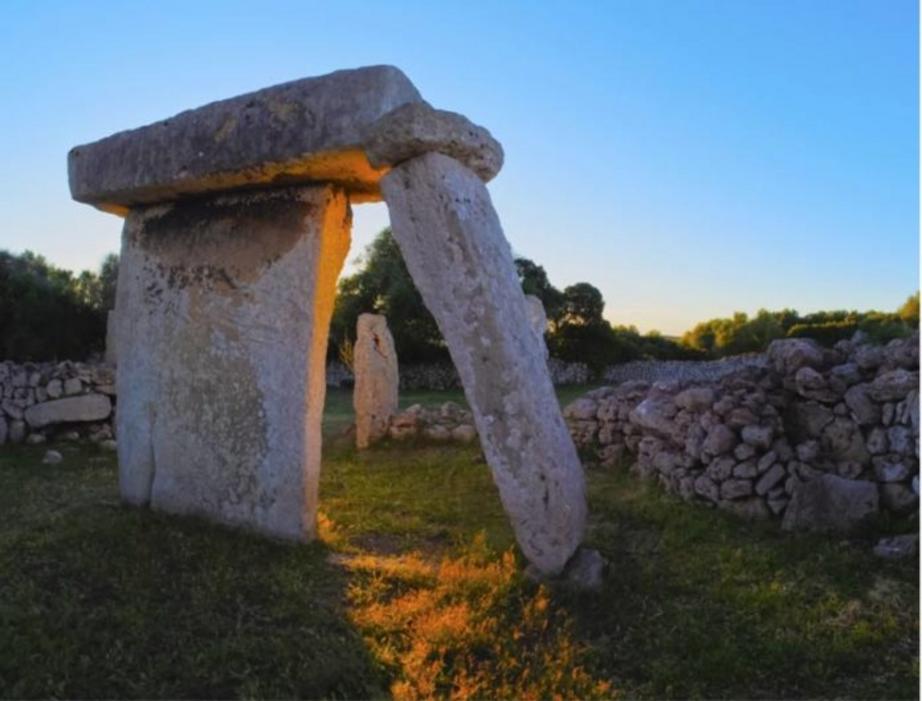
Taulas of Menorca
On the island of Menorca stands a monument with taulas as tall as 3.7 meters. The taulas date back thousands of years to between 1000 BCE and 300 BCE. There is very little known about them or how they were created. There are numerous theories about the site such as that the stones had religious or astronomical significance. Archaeologist Michael Hoskin has posited the idea that the stones were part of an ancient healing cult.
The island of Menorca is a very small rocky island and it is only 50 km across at its widest point. There are 35 separate stone megaliths found on the small island which makes it a place of great interest for archaeologists. What continues to intrigue archaeologists is that the stone structures look very similar to those found at Stonehenge in England and Gobekli Tepe in Turkey.
The taulas were built by the Talayotic people who lived on the island since 2000 BCE and thrived on the tiny island until the Romans arrived in 125 BCE. The people who built the stone megaliths left behind no documentation or information about why they were built which leaves very little for archaeologists to go on. Even the name “taulas” means table in the island’s Catalan language and references how the stone appeared before excavation. Originally all that could be seen of the megaliths were the flat tops which appeared like tables to the locals.
Some suggest that the taulas were the representation of the ancient God much like the cross is to Christians. A bronze bull statue found at the site have led some to wonder if the taulas are meant to represent the face of a bull and that the ancients who built the site worshiped a bull god. Another theory is that the temple was built to be oriented to the Centaurus constellation which support the theory that it was built for the healing cult.
Longyou Caves
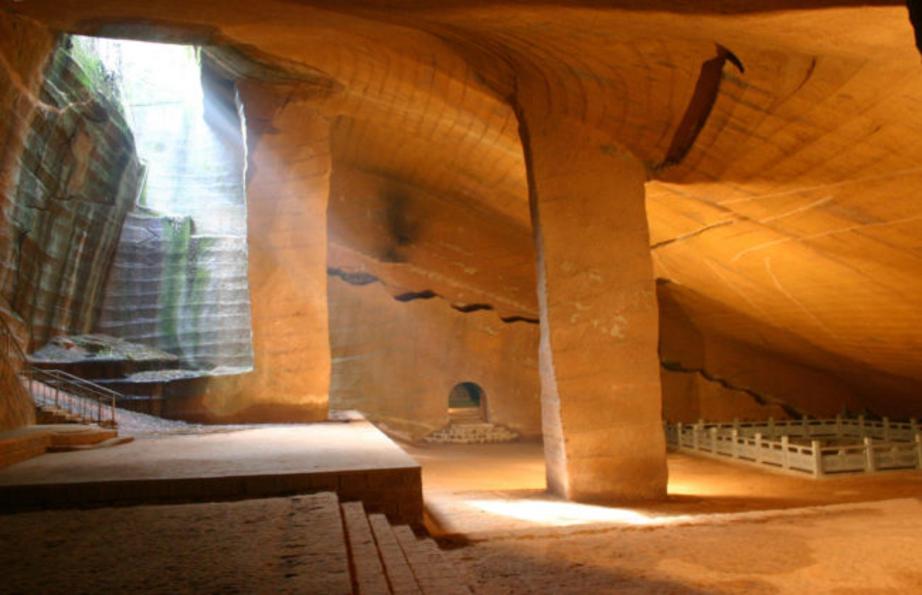
One of the Longyou Caves
The Longyou Caves are found near the village of Shiyan Beicun in the Zhejiang province in China. They are believed to date all the way back to 212 BCE during the Qin dynasty. What makes the caves particularly remarkable is that it would have taken a monumental effort to create them but there is no record at all of their construction or existence. The caves were first found in 1992 and that is the first that anyone had ever heard of the mysterious caves. Since the initial discovery 24 caves have been found and one of them is now a tourist attraction.
The caves are located at Phoenix Hill. They are carved into sandstone and are massive for being completely man-made caves. There average floor space of the caves is 1,000 square meters (11,000 square feet). The height of the caves is also substantial reached up to 30 meters (98 feet) and the total covered area is 30,000 square meters (320,000 square feet).
Throughout the caves are pillars that are evenly spaced in order to support the ceiling. The walls, ceiling and columns are decorated with parallel chisel marks. There are also carvings that depict animals such as a horse, fish and bird. It has been estimated that just to dig out the tunnels would take 1,000 people working around the clock for six years. Added to that the care and precision of the sculpting and the carvings inside the caves would add years to its construction.
The caves are also remarkably preserved. There is no sign of rubble or debris and the carvings are still completely clear and precise. Despite the excellent condition of the caves there remains no evidence of who could have built them. Only someone like an emperor could have commissioned such a massive project but then there is no explanation for why there would be no record of such a project in the historical records. There is also no explanation for why the caves were built or what they were used for.
Underground Italian Pyramids at Orvieto

Excavating the underground Etruscan pyramid
The Italian city of Orvieto has long been known as a place to view medieval ruins but just recently it has become the focus of archaeologists for another reason. In 2011 it was discovered that there are ruins underneath the city that date back to the Etruscans. The Etruscans were a sophisticated culture that existed in Italy around 900 BCE. The society would eventually blend into the Roman empire which makes it harder for archaeologists to fully understand their culture today.
Archeologists have been able to excavate 15 meters (49 feet) down to uncover underground pyramids. The site had been intentionally backfilled for reasons that have yet to be understood. The fill material has been a boon for finding artifacts from the 5th century BCE when the pyramids must have been filled. What has been of particular interest to archeologists is the number of Etruscan language inscriptions that have been found, more than 150. This could lead to a greater understanding of the Etruscans.
It is believed that there are at least five pyramids below the city but only two of them have started to be excavated. The process is very slow and painstaking as artifacts need to be preserved and the site itself must be protected as archeologists dig further down. There are still no answers as to the purpose of the pyramids. It is clear that it was not a quarry because the walls are too smooth and precise.
Researchers also do not know why the pyramids were built or what they were used for. Theories about whether they are religious structures or tombs continue but there has been no definitive evidence to point in either direction as of. Claudio Bizzarri who works at the site believes that they will only find the answer at the bottom of the caverns but no one knows just how far down they will have to dig to get there.

